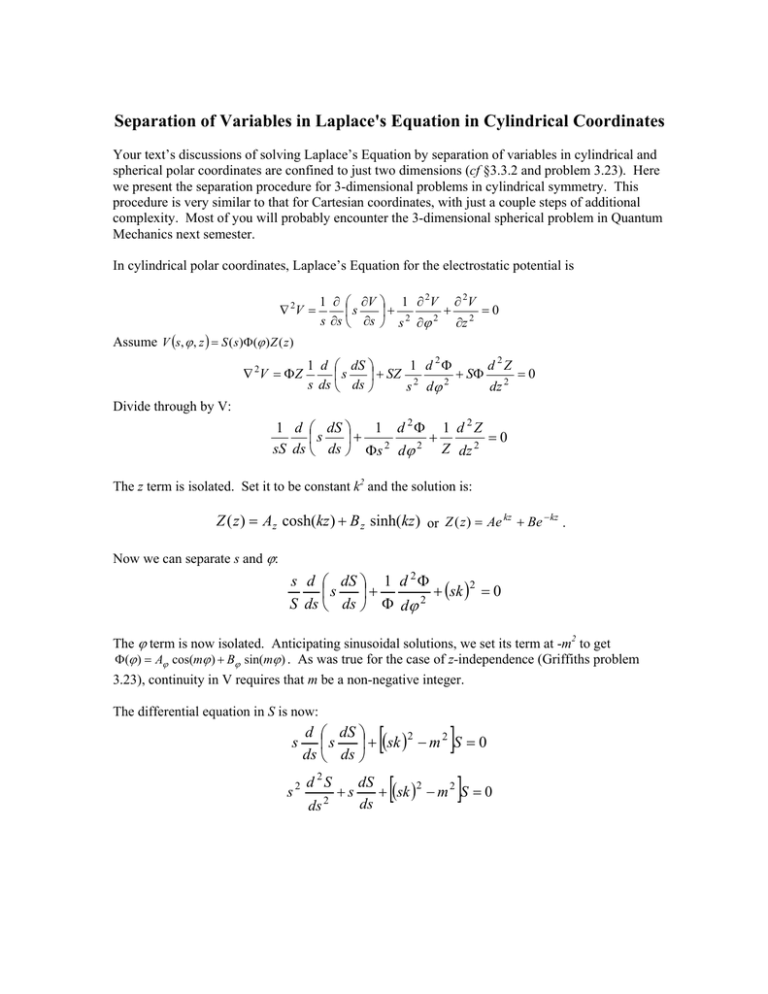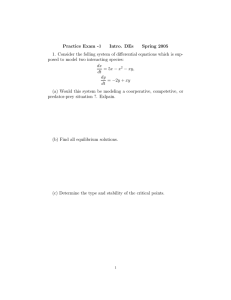Laplace's Equation in Cylindrical Coordinates: Separation of Variables
advertisement

Separation of Variables in Laplace's Equation in Cylindrical Coordinates Your text’s discussions of solving Laplace’s Equation by separation of variables in cylindrical and spherical polar coordinates are confined to just two dimensions (cf §3.3.2 and problem 3.23). Here we present the separation procedure for 3-dimensional problems in cylindrical symmetry. This procedure is very similar to that for Cartesian coordinates, with just a couple steps of additional complexity. Most of you will probably encounter the 3-dimensional spherical problem in Quantum Mechanics next semester. In cylindrical polar coordinates, Laplace’s Equation for the electrostatic potential is ∇ 2V = Assume V (s, ϕ , z ) = S ( s)Φ(ϕ ) Z ( z ) ∇ 2V = Φ Z 1 ∂ ⎛ ∂V ⎞ 1 ∂ 2V ∂ 2V + =0 ⎟+ ⎜s s ∂s ⎝ ∂s ⎠ s 2 ∂ϕ 2 ∂z 2 1 d ⎛ dS ⎞ 1 d 2Φ d 2Z + S Φ =0 ⎜s ⎟ + SZ 2 s ds ⎝ ds ⎠ s dϕ 2 dz 2 Divide through by V: 1 d ⎛ dS ⎞ 1 d 2Φ 1 d 2 Z + =0 ⎜s ⎟+ sS ds ⎝ ds ⎠ Φs 2 dϕ 2 Z dz 2 The z term is isolated. Set it to be constant k2 and the solution is: Z ( z ) = Az cosh(kz ) + B z sinh(kz ) or Z ( z ) = Ae kz + Be − kz . Now we can separate s and ϕ: s d ⎛ dS ⎞ 1 d 2 Φ + (sk )2 = 0 ⎜s ⎟+ 2 S ds ⎝ ds ⎠ Φ dϕ The ϕ term is now isolated. Anticipating sinusoidal solutions, we set its term at -m2 to get Φ(ϕ ) = Aϕ cos(mϕ ) + Bϕ sin(mϕ ) . As was true for the case of z-independence (Griffiths problem 3.23), continuity in V requires that m be a non-negative integer. The differential equation in S is now: s s2 [ ] d ⎛ dS ⎞ 2 2 ⎜s ⎟ + (sk ) − m S = 0 ds ⎝ ds ⎠ d 2S ds 2 +s [ ] dS + (sk )2 − m 2 S = 0 ds Define dimensionless variable u = ks: ⎛ 2 ⎞ d ⎛ dS ⎞⎛ du ⎞ 2⎜ d S ⎟ =k ⎜ ⎟⎜ ⎟ = k ⎜ 2 ⎟ . So the S equation becomes: du ⎝ du ⎠⎝ ds ⎠ ⎝ du ⎠ d 2S Similarly, dS dS du dS = =k ds du ds du ds 2 u 2 d 2S du 2 +u [ ] dS + u 2 − m2 S = 0 du This is Bessel's differential equation. Linearly independent solutions are typically denoted Jm(u) (Bessel Functions) and Nm(u) (Neumann Functions). Their properties are described in standard math handbooks. The first few of these functions are pictured here. Neumann Functions Bessel Functions of the First Kind 1 0.5 J0(x) 0.8 J1(x) 0 0 0.6 2 4 6 8 10 12 14 0.4 Nn(x) Jn(x) J2(x) 0.2 -0.5 N0(x) N1(x) -1 N2(x) 0 0 2 4 6 8 10 12 14 -1.5 -0.2 -2 -0.4 x x Thus, the general solution to Laplace’s Equation in cylindrical coordinates (s,ϕ,z) is something like: V (s, ϕ , z ) = ∞ ∑ [A mJm (ks ) + Bm N m (ks)]⋅ [C m sin (mϕ ) + Dm cos(mϕ )]⋅ [E m sinh (kz ) + Fm cosh(kz)] m=0 It should not be surprising to read that in solving real problems with this method, the hard part begins after this point with the determination of the expansion coefficients to satisfy the boundary conditions of the problem. There is usually some quantification condition on the parameter k necessary to force the solution to meet radial boundary conditions. For example, consider a more particular situation in which the potential is zero at specified radius s = a and we wish to know the potential inside the cylinder. Now the Bmn terms must all be zero to keep the potential finite as s →0. Only certain values of k are allowed to force the radial variable kmna = χmn where χmn is the nth zero of the mth Bessel function (values are available in tables, Mathematica, etc). ∞ ∞ V (s, ϕ , z ) = ∑∑ J m (k mn s )[Cmn sin (mϕ ) + Dmn cos(mϕ )] ⋅ [Emn sinh (k mn z ) + Fmn cosh(k mn z )] m =0 n =1 Finally, in the special case of a potential depending on s only, (as in the long uniformly charged straight wire) this form gives a trivial constant solution. In this case, return to the original Laplace differential equation expressed in terms of the only variable. Its solution is then straightforward and should be very familiar.

